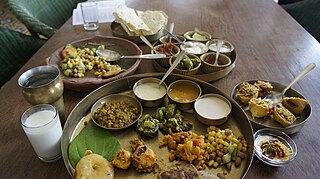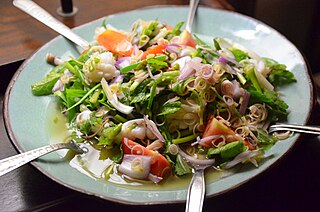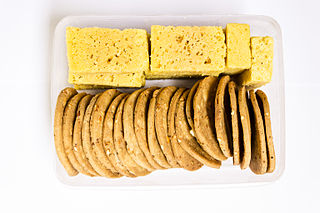
Malaysian cuisine consists of cooking traditions and practices found in Malaysia, and reflects the multi-ethnic makeup of its population. The vast majority of Malaysia's population can roughly be divided among three major ethnic groups: Malays, Chinese and Indians. The remainder consists of the indigenous peoples of Sabah and Sarawak in East Malaysia, the Orang Asli of Peninsular Malaysia, the Peranakan and Eurasian creole communities, as well as a significant number of foreign workers and expatriates.

Malay cuisine is the traditional food of the ethnic Malays of Southeast Asia, residing in modern-day Malaysia, Indonesia, Singapore, Brunei, Southern Thailand and the Philippines as well as Cocos Islands, Christmas Island, Sri Lanka and South Africa.

Butter chicken, traditionally known as murgh makhani, is an Indian dish originating in Delhi. It is a type of curry made from chicken with a spiced tomato and butter (makhan) sauce. Its sauce is known for its rich texture. It is similar to chicken tikka masala, which uses a tomato paste.

Tamil cuisine is a culinary style of Tamil people originating in the southern Indian state of Tamil Nadu and neighboring Sri Lanka. Meats, along with rice, legumes, and lentils, are popular. Dairy products and tamarind are used to provide sour flavors. On special occasions, traditional Tamil dishes are served in a traditional manner, using banana leaves in place of utensils. After eating, the banana leaves are then used as a secondary food for cattle. A typical breakfast meal consists of idli or dosa with chutney. Lunch includes rice, sambar, curd, kuzhambu, and rasam.

Penang cuisine is the cuisine of the multicultural society of Penang, Malaysia. Most of these cuisine are sold at road-side stalls, known as "hawker food" and colloquially as "muckan carts". Local Penangites typically find these hawker fares cheaper and easier to eat out at due to the ubiquitousness of the hawker stalls and that they are open for much of the day and night. Penang island. On February 22, 2013, Penang was ranked by CNN Travel as one of the top ten street food cities in Asia. Penang has also been voted by Lonely Planet as the top culinary destination in 2014.

Palak paneer or palak chhena is an Indian dish consisting of chhena or paneer in a thick paste made from puréed spinach, called palak in Hindi, Marathi, Gujarati, and other Indian languages.

Noodle soup refers to a variety of soups with noodles and other ingredients served in a light broth. Noodle soup is a common dish across East Asia, Southeast Asia and the Himalayan states of South Asia. Various types of noodles are used, such as rice noodles, wheat noodles and egg noodles.

Gujarati cuisine is the cuisine of the Indian state of Gujarat. The typical Gujarati thali consists of rotli, dal or curry, rice, and shaak. The thali will also include preparations made from pulses or whole beans such as moong, black eyed beans etc., a snack item (farsaan) like dhokla, pathra, samosa, fafda, etc. and a sweet (mishthaan) like mohanthal, jalebi, sevaiya etc.

Shami kabab or shaami kabab is a local variety of kebab, originating from the Indian subcontinent. It is a popular dish in modern-day Indian, Pakistani and Bangladeshi cuisines. It is composed of a small patty of minced meat, generally beef, but occasionally lamb or mutton, with ground chickpeas, egg to hold it together, and spices. Shami kebab is eaten as a snack or an appetizer, and is served to guests especially in the regions of Dhaka, Deccan, Punjab, Kashmir, Uttar Pradesh and Sindh.

Madras curry or Madras sauce is a curry sauce. Madras is orange in colour and is made with heavy use of chili powder. Raita is often used as an accompaniment to the dish.
Bangude pulimunchi is a Mangalorean mackerel based dish of coastal Karnataka in southwest India. The dish uses tamarind, a distinctive ingredient in traditional Mangalorean cuisine, to impart tanginess. Another local mackerel dish is bangude masala, which is popular in the coastal districts of Dakshina Kannada and Udupi.

Burmese salads are a diverse category of indigenous salads in Burmese cuisine. Burmese salads are made of cooked and raw ingredients that are mixed by hand to combine and balance a wide-ranging array of flavors and textures. Burmese salads are eaten as standalone snacks, as side dishes paired with Burmese curries, and as entrees. The iconic laphet thoke is traditionally eaten as a palate cleanser at the end of a meal.

Salads that are internationally known as Thai salads with a few exceptions fall into four main preparation methods. In Thai cuisine these are called yam, tam, lap and phla. A few other dishes can also be regarded as being a salad.

Sambal is an Indonesian chili sauce or paste, typically made from a mixture of a variety of chilli peppers with secondary ingredients such as shrimp paste, garlic, ginger, shallot, scallion, palm sugar, and lime juice. Sambal is an Indonesian loanword of Javanese origin. It originated from the culinary traditions of Indonesia and is also an integral part of the cuisines of Singapore, Malaysia, Brunei, and Sri Lanka. It has also spread through overseas Indonesian populations to the Netherlands and Suriname.

Thattai is a deep fried snack from Tamil Nadu made with rice flour and commonly prepared during Pongal and Deepavali festival. It can be salted or sweet. It is known as Nippattu in Karnataka and Chekkalu in Andhra Pradesh/Telangana

Burmese curry refers to a diverse array of dishes in Burmese cuisine that consist of protein or vegetables simmered or stewed in an aromatic curry base. Burmese curries generally differ from other Southeast Asian curries in that Burmese curries make use of dried spices in addition to fresh herbs and aromatics, and are often milder. Burmese curries are readily available in curry houses throughout the country. They are traditionally accompanied with rice and a variety of side dishes, soups, and Burmese salads called athoke. Burmese curries may also be paired with Indian breads like nanbya, palata, aloo puri, and toshay.

Durus kura is a traditional fried chicken curry, one of the most significant Bangladeshi dishes in the Bengali and Rohingya cuisine of Chittagong, which is basically skinless whole chicken cooked in a thick broth. Duroos is typically popular for guests during weddings and other events in Chittagong and Arakan. Duroos can be served with polao or khichuri. Chicken is called kura or kuro in the Bengali language, from which the name derives. Bengali Muslims of Chittagog traditionally serves this dish to the groom in the wedding occasion.
















